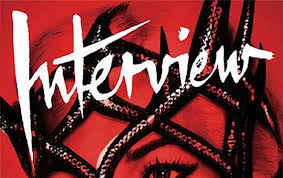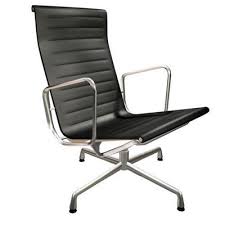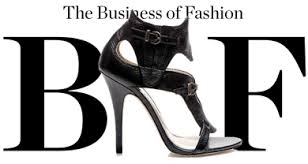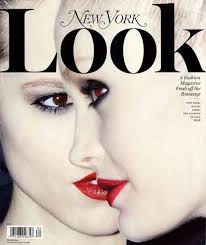(2006) John Christakos, Maurice Blanks, and Charlie Lazor are three friends who met at Williams College in the 1980s. They shared a love for cool furniture -- and a lack of funds to support their cravings. In 1996, the trio launched Blu Dot, a maker of playful, moderately priced, and easy-to-assemble pieces that filled the void between inexpensive Ikea-style goods and luxe furnishings by European firms such as Capellini.
In other words, the Minneapolis-based company's offerings are high-style but moderately priced. Blu Dot found ways to save inventory storage and shipping costs by coming up with pieces that could be stored or packed flat. They also focused on creating pieces that could be assembled without tools when possible -- and included funny directions to win over buyers used to complicated, hard-to-follow instructions. Blu Dot's strategies paid off: In 2005, the privately held company saw sales increase 50%, to $7.5 million. [...]
 Buttercup Chair
Buttercup ChairBlu Dot's lounge chair is made from molded plywood shaped to gently cradle a seated body. It can be used as a comfortable, lightweight, modern alternative to heavy upholstered living room seating -- and is easy to move around when redecorating or relocating.
3D+series-businessweek.jpg) 2D:3D Series
2D:3D SeriesBlu Dot received attention for this series of assemble-it-yourself home and office accessories made from a single sheet of perforated metal. The concept: Each item, like a letter tray or coat rack, can pack totally flat, thus cutting shipping costs and assembly time. Owners put together each item without tools by simply pushing the seamed, two-dimensional cutouts into three-dimensional shapes.
 Barbarella Table
Barbarella TableThis sexy, futuristic table evokes the classic Jane Fonda flick of the same name. The base is made from a single piece of folded metal with a top simply placed on top. It features a slot to accommodate magazines or newspapers. The streamlined construction was designed to pack flat -- thus staying consistent with Blu Dot's goal of keeping shipping costs down.
 Series 11 Drawer
Series 11 DrawerSophisticated and sleek, this drawer set could conceivably be at home equally in a bedroom (for clothes) or a living room (as a media cabinet) -- thus staying consistent with the brand's focus on versatility.
_____________________________________________
The Modern Wing
The 264,000-square-foot Modern Wing - at a cost of $294 million - is the largest expansion in the Art Institute of Chicago's 130-year history. Now a decade in the making, this building makes the Art Institute the second largest art museum in the United States.
 The windows are covered with white screens, lending the views a soft, ghostlike quality. This effect is reinforced by the layering of glass, which shuts out street noise and gives the sight of people walking below a particularly eerie, cinematic quality.
The windows are covered with white screens, lending the views a soft, ghostlike quality. This effect is reinforced by the layering of glass, which shuts out street noise and gives the sight of people walking below a particularly eerie, cinematic quality.The idea is to make you aware of the shifts in daylight — over the course of a visit, from one season to another — without distracting you from the artwork, and the effect is magical.
 It is this obsessive refinement that raises Pritzker Prize-winning architect Renzo Piano's best architecture to the level of art. In an age with few idealists, he exudes a touching faith in the value of slow, incremental progress. He has never fully abandoned the belief that machines can elevate as well as destroy. The beauty of his designs stems from his stubborn insistence that the placement of a column or a window, when done with enough patience and care, brings us a step closer to a more enlightened society.
It is this obsessive refinement that raises Pritzker Prize-winning architect Renzo Piano's best architecture to the level of art. In an age with few idealists, he exudes a touching faith in the value of slow, incremental progress. He has never fully abandoned the belief that machines can elevate as well as destroy. The beauty of his designs stems from his stubborn insistence that the placement of a column or a window, when done with enough patience and care, brings us a step closer to a more enlightened society. The Solomon R. Guggenheim Museum__New York City
The Solomon R. Guggenheim Museum__New York CityQUOTES
The Guggenheim Museum was an aggressive act: Frank Lloyd Wright hated cities. His spiralling museum was, in a way, an attack against the Manhattan street grid.
Many critics see his building as unsympathetic to art: too rigid; a difficult place to install art.
Wright died 6 months before the museum opened.
________________________________________
On the Street with Bill Cunningham: Swoosh!
As the petals of the dogwoods fall, saucy skirts are causing men to turn their heads.
RELATED: Azzedine Alaia - Fall 08
 What Azzedine Alaia is able to do with knitting is remarkable. He produces ruffles and poodle curls that look like lace. The skirt of one outfit, in a boiled black knit, consisted of vertical rows of overlapping circles, like sugar cookies arranged on a buffet tray. And all of these effects are a technical extension of recent work, like the pleated caterpillar dresses worn at last year’s Costume Institute party by Stephanie Seymour and Naomi Campbell, and the new crinkled cotton shirt dresses for spring that use embroidery anglaise.
What Azzedine Alaia is able to do with knitting is remarkable. He produces ruffles and poodle curls that look like lace. The skirt of one outfit, in a boiled black knit, consisted of vertical rows of overlapping circles, like sugar cookies arranged on a buffet tray. And all of these effects are a technical extension of recent work, like the pleated caterpillar dresses worn at last year’s Costume Institute party by Stephanie Seymour and Naomi Campbell, and the new crinkled cotton shirt dresses for spring that use embroidery anglaise.COMMENTS
Alaia just hits the nail on the head, doesn’t he? What’s disappointing is how little his work is photographed- I never see it in magazines or the internet or anywhere, really. I hope this collection is more widely diffused.
Thanks for the inside peek, Cathy. Alaia’s knitwear is indeed incredible - I am still aching at the thought of a skirt of his I neglected to buy on sale from Dover Street Market in January. It was simply but beautifully composed of rounded folds gathered at the waste. What struck me was really the weight of the fabric, which you don’t generally see with modern knitwear, but which was entrancingly muscular here without being stiff in the normal way we think of “constructed” garments.
Thank you for the descriptive process of Alaia…this genius at work. The invisible collaboration of his staff just to reach the stage of the designs that you saw just boggles my mind. He falls in love everytime and surrenders to his ideas and fabrics. What confidence.
C’est difficile, bien sur.
Thanks for the peek inside Mr. Alaia’s atelier. I agree that he is a master of his craft, and too seldom featured in the fashion press (although maybe by his own design). His knitwear is amazing and his techniques always innovative and highly imitated. Like __, I regret not buying an Alaia skirt I should have scooped up for a fraction of the retail price at Filene’s Basement. His work is timeless and, although recognizable, it doesn’t ever succomb to trendiness.
This is going to sound a little selfish on my part, but I’m almost glad Alaïa doesn’t get splashed all over the pages of magazines, because part of the allure is that you have to seek out his work. His most faithful clients aren’t exactly buying his stuff at Barney’s but make the trek out to his fabled atelier in the Marais. It’s an Aladdin’s cave of sumptuousness where they can truly experience (and purchase) the full breadth of his creativity. He closed down his one freestanding store in New York almost a decade ago, and despite the fact various boutiques and specialty department stores stock his wares, you’re still left with the feeling that there is much more to see at his atelier, which has a seductive pull that’s very rare in this age of fast fashion.
What’s interesting about Alaïa’s work is that you notice a clear progression in his thinking. We’ve watched him evolve from very sleek almost skin tight dressing (as if he were trying to whittle the dress down to his purest form) only to move on to shapes that are almost sculptural with more volume (but still body conscious).
____________________________________________
 Under the Bonnet
Under the BonnetThe Tulips and Pansies show, a fund-raiser for Village Care of New York, a health care agency, held at the Edison Ballroom in Manhattan, gave florists a chance to unspool their giddiest fantasies.
_____________________________________________
 Rasika__Washington, D.C.
Rasika__Washington, D.C.Top Chefs on Opening Shop: Starting a Restaurant
So you want to open your own restaurant despite the bad economy? While it may be one of the most rewarding business ventures, it is also one of the riskiest. Conventional wisdom holds that nine out of 10 new restaurants fail during their first year of operation. Although that rate has been debunked, the fact is, opening a restaurant isn't always what it appears from the outside looking in.
With that in mind, BusinessWeek sought out top chef-restaurateurs who've earned rave reviews and awards, respect within the foodie world, and perhaps most importantly—enduring business success.
Lidia Bastianich
Known for her national TV shows, cookbooks and restaurants, Bastianich received the James Beard Foundation's Outstanding Chef award in 2002. The crown jewel in her restaurant empire, Felidia, which she opened in 1981, earned three stars from The New York Times in 1995 and 2006.
Advice to aspiring restaurateurs:
Keep it small, value-driven, and in a beautiful setting. Keep it small, so you can control it and create something of value. It's the survival of the fittest right now—it's not the time to think about getting rich. But if you can build a business in these times and keep it stable—then you can expand on it. Remember that [success] goes beyond a pure formula.
"It's time to be frugal and to be giving. Don't be afraid to give a little extra to your customers. And don't work in a vacuum. Do research. Make seasonal dishes. There's also a philosophy of cooking I was raised on: use as much of your ingredients as you can. Everybody wants a chicken breast, but what happens to the rest of the chicken? Use it.
Mario Batali
Michelin-starred chef-restaurateur behind 14 restaurants, including flagship Babbo in New York City, is the former host of the Food Network's Molto Mario and Ciao America and the author of six cookbooks. He recently launched the PBS series Spain… On The Road Again with his friend Gwyneth Paltrow.
Advice to aspiring restaurateurs:
This month… wait and keep your day job to see just what kind of world we are heading into. The one thing an economic dive does to the restaurant business is weed out the hacks and rookies. If a steady economy prevails and a miracle appears, my advice is to define your customer base in the broadest terms possible and create food and service from the heart, not the textbook or mimicry.
Daniel Boulud
The French-born, Michelin-starred chef-restaurateur behind nine restaurants, including famed Daniel in New York, is the author of six cookbooks and is credited with introducing the gourmet burger at his DB Bistro Moderne restaurant in Manhattan. He was awarded the Chevalier de la Legion d'Honneur by the French government in 2006.
Advice to aspiring restaurateurs:
First, you must be financially sound. Make sure your business plan is more pessimistic than optimistic. One can always deal with success—it is easier to manage than failure. You should raise enough money [to go] for the first three months without the expectation of profitability. If you are profitable in your first month, it is a good sign of longevity. But if it takes six months to profitability, it will be very hard for the rest of your life [in business].
It is very important when you want to open a restaurant to have a name and a reputation or to create one for yourself. You have to have something special to offer people, so that they come back to you again and again.
There are three things you can control in a restaurant: the costs of rent, food, and payroll. Once you have this equation and a little bit of a following, create a wonderful place and build a good team of people who can deal with any task.
 Todd English
Todd EnglishChef Todd English was named best chef in the Northeast by the James Beard Foundation in 1994 for Olives, his Charlestown (Mass.) Mediterranean flagship restaurant. English now has four other Olives locations from New York to Las Vegas, as well as nine other restaurant concepts that bear his name. In 2001, Bon Appetit magazine named him restaurateur of the year.
Advice to aspiring restaurateurs:
It is important to make sure you have enough extra capital in the bank when you open a restaurant. It should be enough to get you through your first several months, but it would be even better if it could get you through your first year.
Wolfgang Puck
The Austrian born, Michelin-starred chef-restaurateur is perhaps best known for his Beverly Hills celebrity haunt Spago and several other fine dining eateries such as Cut, a chain of fast-casual establishments across the country, and a restaurant empire that now spans the globe. He is the author of six cookbooks, the licensor of numerous cooking-related products, and a regular on the Food Network.
Advice to aspiring restaurateurs:
Make your mistakes at someone else's expense, at someone else's restaurant, so that when you open your own, you won't have to pay for it. This means be patient, work hard, mix in a little talent, and when everything comes together, you might be ready to open your own restaurant.
Annie Somerville
The head chef of Greens restaurant in San Francisco earned a national reputation for imaginative vegetarian cooking. Her bestselling cookbooks include Everyday Greens and Fields Of Greens.
Advice to aspiring restaurateurs:
The food makes a restaurant and draws customers in, but you have to have a great business sense or a partner with experience who understands the money flows. At times, the money flows out faster than it flows in. It is a serious business and the profit margins are so slim. Many people don't realize how complicated it is.
If at all possible, I'd say that when you start go into an existing restaurant space. That is a way to go so that you don't spend all of your money just furnishing the kitchen. So many people start out undercapitalized. They spend it all opening and never make it back.























